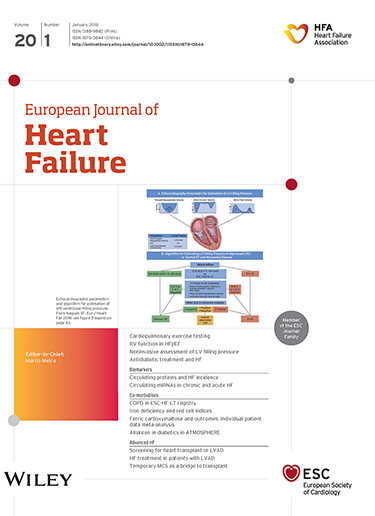Why do people with heart failure die? Rationale and design of the RHYTHM‐HF study
IF 10.8
1区 医学
Q1 CARDIAC & CARDIOVASCULAR SYSTEMS
引用次数: 0
Abstract
AimsThe aim of RHYTHM‐HF is to provide novel insights into the causes and mechanisms of death in near‐consecutive patients discharged following a heart failure hospitalization using data from insertable cardiac monitors (ICMs) and autopsy examinations.MethodsRHYTHM‐HF enrolled an unselected, prospective, near‐consecutive, observational cohort of 257 patients admitted to hospital with a primary diagnosis of decompensated heart failure over a 2‐year period. Potential participants were screened using N‐terminal pro‐B‐type natriuretic peptide and echocardiography. All enrolled participants received a subcutaneously implanted ICM (which provides long‐term cardiac rhythm recordings) before hospital discharge. An optional sub‐study invited participants to consent prospectively to autopsy in the event of death. Following hospital discharge, there was no physical follow‐up, with longitudinal ICM data obtained by remote upload. Participants were followed for up to 4 years. Data permitting determination of the cause, mode and mechanism of death were collected, including ICM‐derived terminal cardiac rhythm and pathological findings at autopsy. Rigorous stepwise clinical adjudication processes were employed in the study (step 1 using clinical data alone, step 2 using additional post‐mortem data, and step 3 using additional terminal rhythm data).ConclusionsThe RHYTHM‐HF study is a contemporary natural history study which investigated causes and mechanisms of death in patients with heart failure. It is the largest study to report terminal rhythm data in patients with heart failure, the largest contemporary prospective autopsy study in heart failure, and the only study to describe the interaction between terminal rhythm and pathological cause of death using modern adjudication standards. We anticipate new mechanistic insights into the cause and mode of death in heart failure. These findings will generate hypotheses for future clinical research into reducing death in heart failure.为什么心力衰竭患者会死亡?RHYTHM‐HF研究的基本原理和设计
目的:RHYTHM‐HF的目的是利用可插入式心脏监护仪(ICMs)和尸检的数据,为心力衰竭住院后近连续出院患者的死亡原因和机制提供新的见解。方法:rhythm‐HF纳入了一项未选择的、前瞻性的、近连续的、观察性队列研究,共纳入257例住院患者,主要诊断为失代偿性心力衰竭,时间为2年。使用N端前B型利钠肽和超声心动图筛选潜在的参与者。所有入选的参与者在出院前都接受了皮下植入ICM(提供长期心律记录)。一项可选的次级研究邀请参与者同意在死亡的情况下进行前瞻性尸检。出院后,没有物理随访,通过远程上传获得纵向ICM数据。参与者被跟踪长达4年。收集了允许确定死亡原因、模式和机制的数据,包括ICM衍生的终末心律和尸检的病理结果。研究采用了严格的分步临床判定流程(第一步单独使用临床数据,第二步使用额外的死后数据,第三步使用额外的末期节律数据)。结论RHYTHM - HF研究是一项当代自然历史研究,旨在探讨心力衰竭患者死亡的原因和机制。这是报道心力衰竭患者终末节律数据的最大研究,也是当代最大的心衰前瞻性尸检研究,也是唯一使用现代裁决标准描述终末节律与病理性死亡原因之间相互作用的研究。我们期待新的机制见解的原因和死亡模式在心力衰竭。这些发现将为未来减少心力衰竭死亡的临床研究提供假设。
本文章由计算机程序翻译,如有差异,请以英文原文为准。
求助全文
约1分钟内获得全文
求助全文
来源期刊

European Journal of Heart Failure
医学-心血管系统
CiteScore
27.30
自引率
11.50%
发文量
365
审稿时长
1 months
期刊介绍:
European Journal of Heart Failure is an international journal dedicated to advancing knowledge in the field of heart failure management. The journal publishes reviews and editorials aimed at improving understanding, prevention, investigation, and treatment of heart failure. It covers various disciplines such as molecular and cellular biology, pathology, physiology, electrophysiology, pharmacology, clinical sciences, social sciences, and population sciences. The journal welcomes submissions of manuscripts on basic, clinical, and population sciences, as well as original contributions on nursing, care of the elderly, primary care, health economics, and other related specialist fields. It is published monthly and has a readership that includes cardiologists, emergency room physicians, intensivists, internists, general physicians, cardiac nurses, diabetologists, epidemiologists, basic scientists focusing on cardiovascular research, and those working in rehabilitation. The journal is abstracted and indexed in various databases such as Academic Search, Embase, MEDLINE/PubMed, and Science Citation Index.
 求助内容:
求助内容: 应助结果提醒方式:
应助结果提醒方式:


